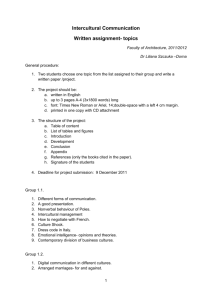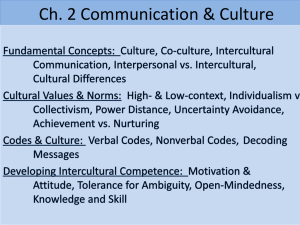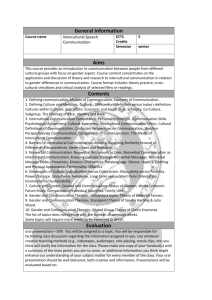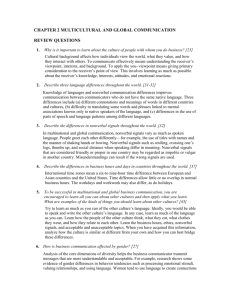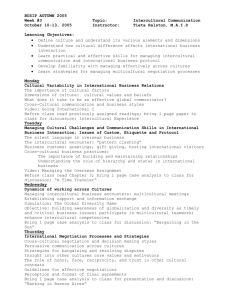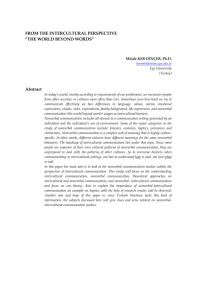Intercultural Communication Written assignment
advertisement
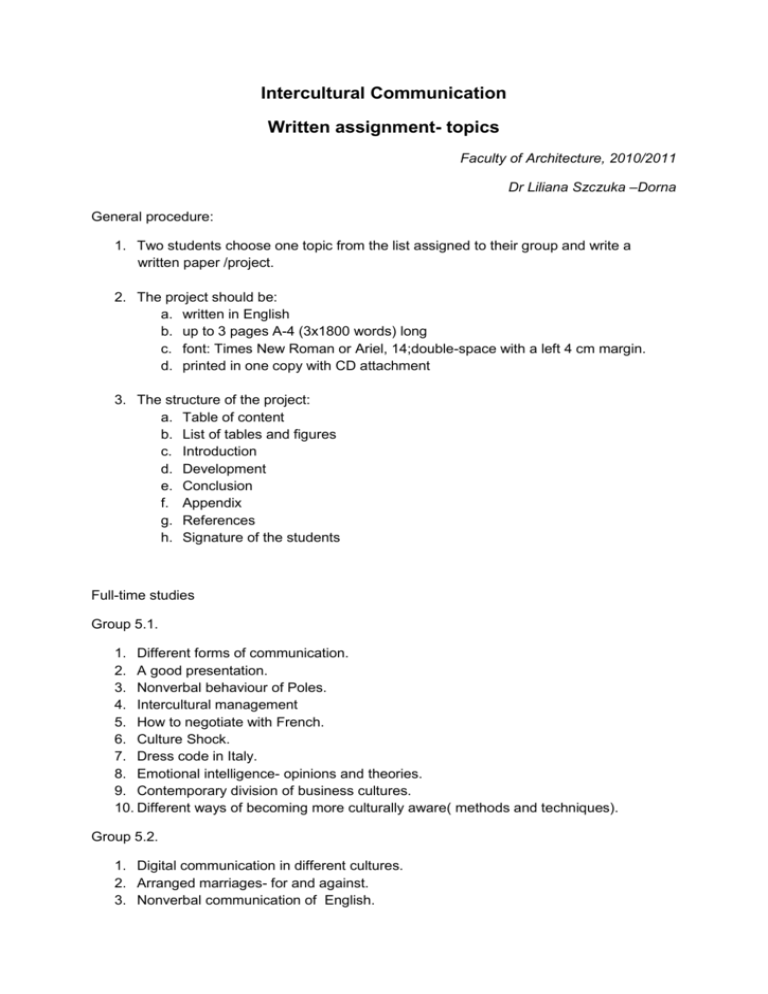
Intercultural Communication Written assignment- topics Faculty of Architecture, 2010/2011 Dr Liliana Szczuka –Dorna General procedure: 1. Two students choose one topic from the list assigned to their group and write a written paper /project. 2. The project should be: a. written in English b. up to 3 pages A-4 (3x1800 words) long c. font: Times New Roman or Ariel, 14;double-space with a left 4 cm margin. d. printed in one copy with CD attachment 3. The structure of the project: a. Table of content b. List of tables and figures c. Introduction d. Development e. Conclusion f. Appendix g. References h. Signature of the students Full-time studies Group 5.1. 1. Different forms of communication. 2. A good presentation. 3. Nonverbal behaviour of Poles. 4. Intercultural management 5. How to negotiate with French. 6. Culture Shock. 7. Dress code in Italy. 8. Emotional intelligence- opinions and theories. 9. Contemporary division of business cultures. 10. Different ways of becoming more culturally aware( methods and techniques). Group 5.2. 1. Digital communication in different cultures. 2. Arranged marriages- for and against. 3. Nonverbal communication of English. 4. How to negotiate with Germans. 5. Dress code in China. 6. How to solve intercultural conflicts. 7. How to organize brunch and gala dinner. 8. How to write a good report. 9. R. Covey-his theory *8 habits of effective life. 10. Does bilingual children mean bilingual culture? Group 5.3. 1. Nonverbal communication of Spanish. 2. Exchanging business cards in different cultures. 3. Different forms of business small talk. 4. English as lingua franca. 5. American management practices. 6. Kisses and hugs in formal meetings in different cultures. 7. How to improve writing skills. 8. Dress code in India. 9. Do we need Power Point presentations? 10. Code of ethics in contemporary business- examples. Group 5.4. 1. How to organize wine reception and lunch. 2. How to improve speaking skills. 3. Nonverbal behavior of Scandinavians. 4. Stereotypes and their role in communication. 5. How to negotiate with Russians. 6. French management practices. 7. Dress code in Poland and Japan- differences and similarities. 8. Tony Brian- theories for contemporary managers. 9. Gestures- for and against their use in business. 10. Presents in the business world- for and against. Group 5.5. 1. Nonverbal behavior of Mexicans. 2. Dress code in America. 3. Ice-breakers: how to start a meeting with strangers. 4. Physical appearance: creating good impression during meetings. 5. Individualism and collectivism. 6. Politeness in Poland and Japan- comparison. 7. Do’s and taboos of Polish culture. 8. Power distance in different cultures. 9. Doing business in Netherlands. 10. Intercultural organizations- examples and best practice. Group 5.6. 1. Nonverbal behavior of Egyptians. 2. Proxemics in different cultures. 3. Benefits of intercultural communication. 4. Kluckhohn and Strodtbeck’s value orientations. 5. Japanese housing. 6. Intercultural Communication Competence. 7. Do’s and taboos of American culture. 8. Empathy and similarity in two selected cultures. 9. Sex and gender roles in Japan and Saudi Arabia. 10. Intercultural Communication on the web pages- a resource file. Group 5.7. 1. The importance of body language in students’ communication at university. 2. How to understand Chinese? 3. Improving speaking skills. 4. Presents in business contacts. 5. Written communication in business- forms and their usage. 6. Small talks with business partners- topics to be avoided. 7. How to behave during business meetings. 8. B. Tracy and his philosophy of business culture. 9. Verbal greetings. 10. Perception of time in cultures. Group 5.8. 1. Preparing a business meeting. 2. How to understand African cultures. 3. Compare Polish, German and French negotiator. 4. Describe Polish business culture. 5. Examples of business dress code. 6. Important elements of written communication. 7. How to improve listening skills? 8. Business etiquette- preparing meals. 9. Silence in cultures. 10. How to read “space and territory” in different cultures? Evening classes: groups 10A-1 and 10A-2 Group 10A-1 1. 2. 3. 4. Dress code in Bulgaria. Business etiquette. How to improve listening skills. Bribes- to give or not to give. 5. Geert Hofstede- division of cultures. 6. Norwegian management practices. 7. The meaning of silence in business meetings. 8. Business correspondence- different forms. 9. Nonverbal behavior of Canadian. 10. Nonverbal communication at university. Group 10A-2 1. Presents during official meetings. 2. Dress code in Greece. 3. E. Hall and his division of cultures. 4. Definitions of nonverbal communication. 5. How to negotiate with Arabs. 6. How to improve negotiating skills. 7. Gender stereotypes in two selected cultures. 8. Giving a talk- important elements of public speaking. 9. Culture shock in Poland- how to help foreigners in our country. 10. G. Hofstede and his index of cultures. Describe one business culture.
